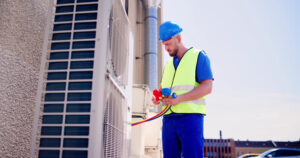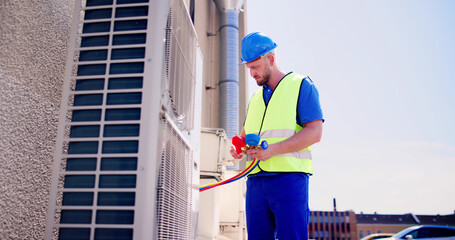Refrigeration installation is a crucial step to properly equip your business with the right refrigerator for its size and needs. Without a professional, refrigeration systems can become damaged and not function as intended.
Following the manufacturer’s instructions that come with your new refrigerator is always recommended. If you have misplaced or discarded those instructions, this article will provide you with general guidelines to follow for a smooth refrigeration installation. All Temp Air Conditioning & Refrigeration systems can provide you with the quality refrigerator water line installation services that you need.
 Water Line
Water Line
A refrigerator water line runs from a home’s plumbing to the fridge and is essential for delivering cold, fresh water to your kitchen appliances. Unlike standard plumbing pipes, the refrigerator line is typically made of a specialized type of plastic or copper tubing and needs to be a certain size to prevent leaks. If your refrigerator has a problem with its water line, you’ll want to find a professional plumber near me to fix it for you.
Before your tradie arrives, be sure to shut off the water supply valve to your house’s refrigerator water line. If you’re not sure where the valve is located, consult your refrigerator’s owner’s manual or contact an expert to help you locate it. Then, check that your refrigerator water line fitting kit includes a stop valve and tubing long enough to reach from the shut-off valve to your fridge.
Once your tradie has found the nearest cold water pipe, they’ll map out the shortest possible route for the tubing. This will minimize the risk of leaking or crimping. Once they’ve determined what supplies they need, they’ll order them and prepare to connect the new fridge line.
If the fridge is in a brand-new home, the home builder may have already anticipated this requirement and left a water valve in place for the purpose. If not, your tradie will need to remove a section of the pipe and solder in a regular copper tee adapter. If your pipes are made of CPVC or steel, use tee adapters that match those materials.
Your tradie will then test the refrigerator water line to ensure that it works correctly. They will flush the line to eliminate any sediment or trapped air. They’ll also disconnect the old water line from the shut-off valve, and clean the area around the fridge before they finish their work. After your fridge water line has been installed, you can enjoy ice-cold drinks and unlimited filtered water.
Electrical Outlet
Electrical outlets (also called sockets, plugs, or wall plugs) allow equipment to connect to your home’s electrical system. They’re found in rooms throughout your house, and they are used to power everything from appliances to light fixtures and electronics.
There are several different kinds of electrical outlets, and each one has its purpose. Understanding what each type of outlet is best for can help you prevent accidents and make sure your home has the most efficient electrical setup possible.
The first kind of electrical outlet is the two-prong type. This is the standard outlet in homes built up to 50 years ago, and it still exists in many homes today. It features two long connection slots and is designed to be used on ungrounded circuits. These outlets are the least safe and should be replaced with the three-prong variety, which is safer.
A 3-prong outlet features a third vertical slot that is designed to hold a grounding pin. This helps to prevent electric shock in the event of a short or loose wiring problem with your appliances or other electrical devices. This type of outlet is the most common in homes today and it’s required by most current building codes.
There are also outlets, which have been designed to protect your family from electrical hazards in the event of water or moisture contact. These are commonly used in bathrooms, laundry rooms, basements, and outdoors. They look much like the other types of outlets, but they have a special feature that protects against electric shock in the event of water or moisture infiltration.
Lastly, some outlets provide a permanent Universal Serial Bus (USB) connection point for charging devices like phones and tablets. These outlets are also common in the offices of modern startups, where many employees work on their computers and other mobile devices.
Before working on any electrical outlets, it’s important to turn off the power to the room where you’re working. You can do this by switching off the appropriate breaker at your home’s main service panel, which is usually located in a utility room, garage, or basement. You can also use a non-contact voltage tester to check for power at an outlet before you touch it.
Refrigeration
Refrigeration is a crucial piece of modern life, whether it’s for transporting food in refrigerated rail cars and trucks or cooling our refrigerators at home. The technology has evolved over the past century from ice harvesting to temperature-controlled rail cars and fridges.
The most basic refrigeration system works by circulating a refrigerant through coils in the condenser. The coils are located on the outside of the unit and are cooled by air that blows over them. The cooled air is then circulated back into the refrigerator to keep it cold.
To install a new refrigerator, first make sure your space can accommodate it. Then, remove the base grille and lower access panel, if applicable. Locate the leveling legs on the bottom of your refrigerator and adjust them as needed to ensure they sit flat. Refer to your owner’s manual for specific instructions.
Next, plug the power cord into a grounded outlet that is on a dedicated circuit. This prevents tripping the breaker if another kitchen appliance is used when the refrigerator’s compressor is running. If you’re installing a freezer or refrigerator drawer handle, align the set screws with their mounting studs and use an appropriate-size wrench to tighten them. Once the handles are secured, attach a screw cap to cover the holes.
It’s essential to establish a routine maintenance schedule for your refrigeration system, and this is especially true if you have a large commercial refrigeration infrastructure. Regular inspections can catch problems before they balloon into expensive system failures. However, these inspections are only helpful if your service team understands your unique business’s needs in addition to the refrigeration system itself.
Many refrigeration issues are due to inadequate system design and sizing, poor end-user use intentions, or improper installation. By working with qualified professionals and establishing a routine maintenance schedule, you can avoid these issues altogether.
Installation
When a refrigeration system is properly installed, it can function and perform as intended in the home. This process can be relatively easy to do as long as certain steps are followed and the necessary safety precautions are taken. Among these are measuring the space in which the refrigerator will be installed, assembling the support system, and connecting the power cord and water line. In addition, it is important to leak-test and charge the refrigerant to ensure optimal functionality of the appliance.
The first step in installing a refrigeration system is to prepare the space where it will be placed by covering the floor with cardboard or a towel and unplugging any existing appliances. Then, the refrigerator must be moved into place and plugged in. During this time, it is vital to use caution when transporting the appliance to avoid any injuries or damage. If possible, it is recommended that two people move the fridge.
Once the refrigerator is in its permanent location, it can be moved back out of the way to allow access to the water line. Then, it is a good idea to install hangers around the area where the lines pass through to ensure they do not come loose or get pinched. Once the hangers are in place, the refrigeration lines can be connected to the back of the refrigerator and then pushed through the wall to connect to the water valve.
When connecting the refrigerator water supply, it is a good idea to have a bucket or pan ready to catch any drips. It is also a good idea to shut off the main water line to the house before proceeding. Then, the refrigerator’s water inlet connector can be removed by unscrewing it using a pair of pliers. Afterward, the copper tubing can be inserted into a new water inlet connector or saddle valve (depending on the model) and tightened by hand to create a seal.
Once the water connection is made, it’s important to turn on the refrigerator and test the temperature settings. It is also a good idea to regularly clean the refrigerator’s coils to keep it functioning optimally.

